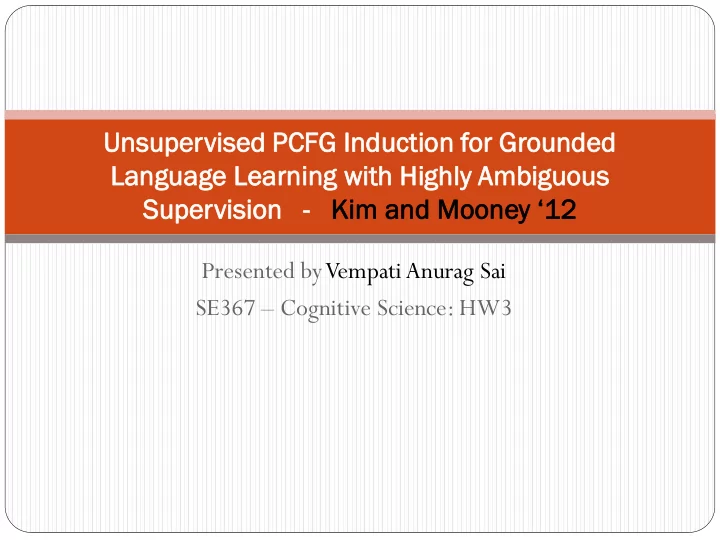

Uns Unsup uper ervis vised ed PC PCFG FG Ind nduc ucti tion on for r Grounde ounded d Langu guage ge Lea earnin ing w g wit ith Hig ighly y Ambig biguou uous s Supe pervisi ision on - Kim and Mooney ‘12 Presented by Vempati Anurag Sai SE367 – Cognitive Science: HW3
Introduction “Grounded” language learning Given sentences in NL paired with relevant but ambiguous perceptual context, being able to interpret and generate language describing world events. Eg. Sports casting problem (Chen & Mooney (CM), ‘08), navigation problem (Chen & Mooney, ‘11) etc. Navigation Problem : Formally, given training data of the form {(e 1 , a 1 ,w 1 ), . . . , (e N , a N ,w N )}, where e i is an NL instruction, a i is an observed action sequence, and w i is the current world state (patterns of floors and walls, positions of landmarks, etc.), we want to produce the correct actions a j for a novel (e j ,w j ).
Related Work Borschinger et al. (’11) introduced grounded language learning based on PCFG (Probability Context Free Grammar) which did well in low level ambiguity scenarios like sports casting but, fails to scale to tasks where each instruction can refer to a large set of meanings as in Navigation problem. Inside-Outside Algorithm 0.6 0.6 0.6 0.6 +1 0.3 0.1 0.4 0.3 0.4 0.3 0.5 0.3 0.3
Related Work There are combinatorial number of possible meanings for a given instruction which again grows exponential in number of objects and world-states that occur when the instruction is followed. CM’11 avoid enumerating all the meanings and build a semantic lexicon that maps words/phrases to formal representations of actions This lexicon is used for obtaining MR (Meaning representation) for an observed instruction. These MRs are used to train a sematic parser capable of mapping instructions to formal meanings
Proposed Method Our Method: MR for a test Lexeme CM’s Lexicon More focused sentence from the Hierarchy Graph learner PCFG most probable (LHG) parse tree For each action a i , let c i be the landmark plan representing context of each action and landmarks encountered. Now a particular plan p i , as suggested by the instruction would be a subset of c i . As we can see, there are many possible plans that could be MR of an instruction. Combinatorial matching problem between e i and c i Given: Training set with ( e i , c i ) pairs. Lexicon is learnt by evaluating pairs of words/phrases w j , and MR graphs, m j , and scoring them based on how much more likely m j is a subgraph of the context c i when w j occurs in the corresponding instruction e i .
Changes to CM’11 Lexicon learnt by scoring (w j , m j ) pairs p i = arg max j S(w j , m j ) such that, w j belongs to e i (e i , p i ) pairs used as training inputs for semantic parser learner The chunk that is changed
PCFG Framework Lexeme Hierarchy Graph (LHG) Since lexeme MRs are analogous to syntactic categories in that complex lexeme MRs represent complicated semantic concepts whereas simple MRs represent simple concepts, it is natural to construct hierarchy amongst them. Hierarchical sub graph relationships between the lexeme MRs in the learned semantic lexicon to produce a smaller, more focused set of PCFG rules. Analogous to hierarchical relations between non-terminals in syntactic parsing
Continued… Completely built LHG Pseudo Lexems LHGs of all the training examples are used to generate production rules for PCFG. Instead of generating NL words from each atomic MR, words are generated from Lexeme MRs and small Lexeme MRs are generated from complex ones. No Combinatorial explosion!!!!
Continued… k-permutations of child MRs for every Lexeme MR node Production rules generated from LHGs Including k-permutations of child MRs for every Lexeme MR node makes the rule book more rich. This results in producing MRs that weren’t present in the Training set which wasn’t possible in Borshinger et al.
Parsing Novel NL Sentences To learn the parameters of the resulting PCFG, the Inside-Outside algorithm is used. Then, the standard probabilistic CKY algorithm is used to produce the most probable parse for novel NL sentences (Jurafsky and Martin, 2000). Borschinger et al. simply read the MR, m, for a sentence off the top nonterminal of the most probable parse tree. However, in this paper, the correct MR is constructed by properly composing the appropriate subset of lexeme MRs from the most-probable parse tree.
Results Measure of how good the system is able to convert NL sentences into correct MRs in a new test environment: Efficiency in executing novel test instructions:
References Joohyun Kim and Raymond J. 2012. Mooney, “ Unsupervised PCFG Induction for Grounded Language Learning with Highly Ambiguous Supervision ” Benjamin Borschinger, Bevan K. Jones, and Mark Johnson. 2011. “Reducing grounded learning tasks to grammatical inference” David L. Chen and Raymond J. Mooney. 2011. “Learning to interpret natural language navigation instructions from observations”
QUESTIONS???
Recommend
More recommend